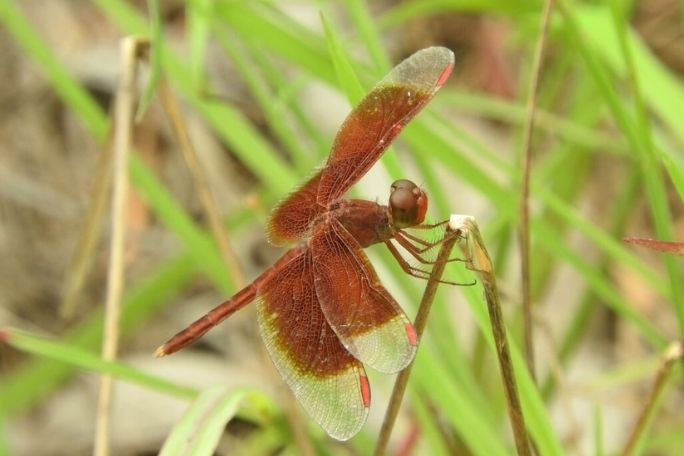Lesson summary
Students will consider the role of entomologists, and the need to catch insects in order to study them. They will then research and analyse various insect collecting methods/devices, before making and creating an insect collection device. Students will then learn why the roles of teams are so important in any collection method.
Learning intentions:
Students will...
- understand the role of the entomologist
- understand that each insect collection method achieves a different result
- understand why teamwork is important when collecting animals.
Success criteria:
Students can...
- analyse one insect collection method
- describe the safe use of one insect collection method
- actively contribute to a team environment while collecting insects.
Lesson guides and printables
Curriculum links
Select your curriculum from the options below.
Lesson details
Curriculum mapping
Australian Curriculum content descriptions:
Year 5 English:
- Plan, create, rehearse and deliver spoken and multimodal presentations that include relevant, elaborated ideas, sequencing ideas and using complex sentences, specialist and technical vocabulary, pitch, tone, pace, volume, and visual and digital features (AC9E5LY07)
- Use appropriate interaction skills including paraphrasing and questioning to clarify meaning, make connections to own experience, and present and justify an opinion or idea (AC9E5LY02)
Year 5 Science:
- Examine how particular structural features and behaviours of living things enable their survival in specific habitats (AC9S5U01)
- Plan and conduct repeatable investigations to answer questions, including, as appropriate, deciding the variables to be changed, measured and controlled in fair tests; describing potential risks; planning for the safe use of equipment and materials; and identifying required permissions to conduct investigations on Country/Place (AC9S5I02)
- Use equipment to observe, measure and record data with reasonable precision, using digital tools as appropriate (AC9S5I03)
Year 6 English:
- Use interaction skills and awareness of formality when paraphrasing, questioning, clarifying and interrogating ideas, developing and supporting arguments, and sharing and evaluating information, experiences and opinions (AC9E6LY02)
- Identify responses to characters and events in literary texts, drawn from historical, social or cultural contexts, by First Nations Australian, and wide-ranging Australian and world authors (AC9E6LE01)
Year 6 Science:
- Investigate the physical conditions of a habitat and analyse how the growth and survival of living things is affected by changing physical conditions (AC9S6U01)
- Plan and conduct repeatable investigations to answer questions, including, as appropriate, deciding the variables to be changed, measured and controlled in fair tests; describing potential risks; planning for the safe use of equipment and materials; and identifying required permissions to conduct investigations on Country/Place (AC9S6I02)
- Use equipment to observe, measure and record data with reasonable precision, using digital tools as appropriate (AC9S5I03)
Syllabus outcomes: EN3-4A, EN3-8D, EN3-1A, EN3-2A, ST3-10LW, ST3-4WS, ST3-11LW
General capabilities: Literacy, Ethical Understanding, Intercultural Understanding, Critical and Creative Thinking, Digital Literacy
Cross-curriculum priority: Sustainability
Relevant parts of Year 5 English achievement standards: Students use language features including topic specific vocabulary and literary devices, and/or multimodal features and features of voice.
Relevant parts of Year 5 Science achievement standards: Students explain how the form and behaviour of living things enables survival. Students identify variables to be changed and measured.
Relevant parts of Year 6 English achievement standards: Students interact with others, and listen to and create spoken and/or multimodal texts including literary texts.
Relevant parts of Year 6 Science achievement standards: Students explain how changes in physical conditions affect living things. Students construct representations to organise and process data and information and describe patterns, trends and relationships
This lesson is part of the wider unit of work Backyard Bush Blitz – Years 5 & 6
Resources required
- Device capable of presenting a website to the class
- Optional – Collection Methods Images
- Optional – buying insect trap methods – see Part C, Step 4
- Student access to devices with internet connection
- Student Worksheets – one copy per group
- Workbooks
Skills
This lesson is designed to build students’ competencies in the following skills:
- Communication
- Creativity
- Critical thinking
- Cultural understanding
Additional info
Time required: 130+ mins
Level of teacher scaffolding: Medium to High depending on class needs. Mixed level writing and designing of species collection methods
This is an original Cool+ lesson.


Welcome back!
Don't have an account yet?
Log in with:
Create your free Cool.org account.
Many of our resources are free, with an option to upgrade to Cool+ for premium content.
Already have an account?
Sign up with:
By signing up you accept Cool.org's Terms and Conditions(Opens in new tab) and Privacy Policy(Opens in new tab).